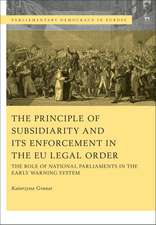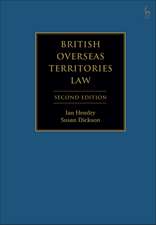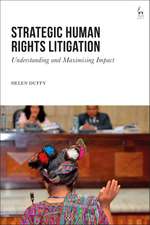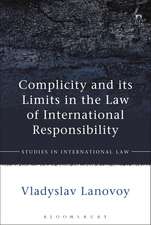Linkages and Boundaries in Private and Public International Law
Editat de Veronica Ruiz Abou-Nigm, Kasey McCall-Smith, Duncan Frenchen Limba Engleză Paperback – 4 noi 2020
| Toate formatele și edițiile | Preț | Express |
|---|---|---|
| Paperback (1) | 298.74 lei 6-8 săpt. | |
| Bloomsbury Publishing – 4 noi 2020 | 298.74 lei 6-8 săpt. | |
| Hardback (1) | 569.60 lei 6-8 săpt. | |
| Bloomsbury Publishing – 25 iul 2018 | 569.60 lei 6-8 săpt. |
Preț: 298.74 lei
Preț vechi: 365.34 lei
-18% Nou
Puncte Express: 448
Preț estimativ în valută:
57.17€ • 59.06$ • 47.58£
57.17€ • 59.06$ • 47.58£
Carte tipărită la comandă
Livrare economică 26 martie-09 aprilie
Preluare comenzi: 021 569.72.76
Specificații
ISBN-13: 9781509943715
ISBN-10: 1509943714
Pagini: 272
Dimensiuni: 156 x 234 mm
Greutate: 0.39 kg
Editura: Bloomsbury Publishing
Colecția Hart Publishing
Locul publicării:London, United Kingdom
ISBN-10: 1509943714
Pagini: 272
Dimensiuni: 156 x 234 mm
Greutate: 0.39 kg
Editura: Bloomsbury Publishing
Colecția Hart Publishing
Locul publicării:London, United Kingdom
Caracteristici
Collection draws on expertise of public and private international lawyers, both academic and practitioner.
Notă biografică
Verónica Ruiz Abou-Nigm is Senior Lecturer in International Private Law at the University of Edinburgh. Kasey McCall-Smith is Lecturer in Public International Law at the University of Edinburgh. Duncan French is Professor of International Law at the University of Lincoln.
Cuprins
Introduction: Systemic Dialogue: Identifying Commonalities and Exploring Linkages in Private and Public International Law Verónica Ruiz Abou-Nigm, Kasey McCall-Smith and Duncan French Part I: Discerning Synergies and Shared Values in International Law1. Connecting Public and Private International Law Alex MillsI. Introduction II. Sources III. Connections IV. Conclusions 2. Windows in International Law Jean d'Aspremont and Francesco GiglioI. Introduction II. Roman Interpretation: Between Strict and Flexible Legal Analysis III. Private and Public International Law as Professionally Distinct Fields IV. New Descriptive Tools for Private and Public International Law V. Windows, (De)coders and Travellers in Private and Public International Law VI. Public International Law VII. Concluding Remarks 3. 'International' Rules in an Internal Setting Kirsty J Hood, QCI. Introduction II. Case Study: The United Kingdom III. Conclusion Part II: Functional Commonalities in International Law4. Jurisdiction: Betwixt Unilateralism and Global Coordination Duncan French and Verónica Ruiz Abou-NigmI. Introduction II. Jurisdiction: 'Many, Too Many, Meanings' III. Trends towards a Global 'System'? IV. Bases of Jurisdiction V. Jurisdiction in Private International Law: Global Connectivity and 'Justice Pluralism' VI. Public International Law Jurisdiction: Somewhere between Law and Power VII. Improving Coordination of Jurisdictional Frameworks in Private and Public International Law VIII. Conclusions 5. On the Dwindling Divide between the Public and Private: The Role of Soft Law Instruments in Global Governance Richard Collins and María Mercedes AlbornozI. Introduction: Global Governance and the Confluence of Public and Private International Law II. 'Softness' in Public International Law: 'Deformalisation' and the Emergence of Global GovernanceIII. Soft Law as Governance Technique: The Case of Private International Law IV. Responding to Law's Globalisation? Order and Justice within Contemporary Frameworks 6. The Role of Global Values in the Evaluation of Public Policy in International Investment and ommercial Arbitration María Blanca Noodt Taquela and Ana María Daza-ClarkI. Introduction II. Public Policy as an Exception to Compliance with International Obligations III. Public Policy and the Difficulties in its Definition IV. Public Policy as a Narrow Exception in Private International Law and a Broad Defence in Public International Law V. Types of Global Values that Influence International ArbitrationVI. Incidence of Global Values in the Interpretation of Public Policy in International and Commercial and Investment Arbitration VII. Conclusions Part III: Exploring Linkages and Boundaries in International Law7. Reconciling Human Rights and Supply Chain Management through Corporate Social Responsibility Kasey McCall-Smith and Andreas RühmkorfI. Introduction II. CSR and Global Supply Chain Management: The Developing Legal Framework III. The Barriers in Public International Law IV. The Barriers in Private International LawV. Case Study of the Mobile Phone Industry VI. Towards a Hybrid Regulatory Approach: Transcending the Limits of Private and Public International Law VII. Conclusion 8. Realising the Objectives of Public International Environmental Law through Private Contracts: The Need for a Dialogue with Private International Law Scholars Elisa Morgera and Lorna GilliesI. Introduction II. The Nagoya Protocol and Ad Hoc Private Contracts III. Standardised Contractual Clauses under the International Treaty IV. Overall Reflection 9. International Investment Arbitration and the Arduous Route to Transparency Sharon E FosterI. Introduction II. History III. International Commercial Arbitration in Private International Law: Confidentiality and Privacy as the Norm IV. Investor-State Arbitration in Public International Law: Transparency as the Demand V. Clash of Public Values with Functional Approaches VI. How Private Values and Public Values Meet VII. Dispute Settlement in the Proposed TTIP, TPP and CETA VIII. Conclusions 10. Protecting Whistleblowers: The Roles of Public and Private International Law Dimitrios Kagiaros and Amanda WyperI. Introduction II. Regulatory Approaches to Whistleblowing: Protection and Incentives III. Domestic UK Whistleblowing Regulation IV. Private International Law V. The Contribution of Public International Law to Whistleblowing VI. Which States are Responsible for Providing Protection in a Cross-border Disclosure? VII. Conclusions










